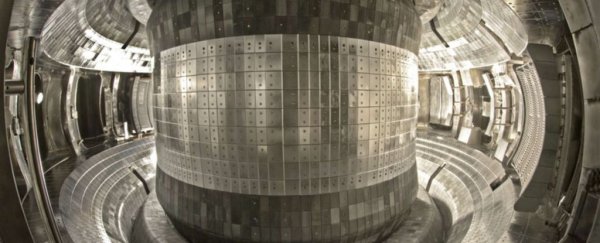Just seven months after it announced a milestone record for plasma fusion, the Chinese Academy of Sciences has absolutely smashed it.
Their 'artificial Sun' tokomak reactor is has maintained a roiling loop of plasma superheated to 120 million degrees Celsius (216 million degrees Fahrenheit) for a gobsmacking 1,056 seconds, the Institute of Plasma Physics reports.
This also beats the previous record for plasma confinement of 390 seconds, set by the Tore Supra tokamak in France in 2003.
This breakthrough by the EAST (Experimental Advanced Superconducting Tokamak, or HT-7U) reactor is a significant advance for fusion experimentation in the pursuit of fusion energy.
Succeeding in the generation of usable amounts of energy via nuclear fusion would change the world, but it's incredibly challenging to accomplish. It involves replicating the processes that take place in the heart of a star, where high pressure and temperature squeeze atomic nuclei together so tightly that they fuse to form new elements.
In the case of main sequence stars, these nuclei are hydrogen, which fuse to form helium. Since one helium nucleus is less massive than the four hydrogen nuclei that fuse to make it, the excess mass is radiated as heat and light.
This generates a tremendous amount of energy – enough to power a star – and scientists are striving to harness the same process here on Earth. Obviously, there's a significant challenge in creating the heat and pressure that we find in the heart of a star, and there are different technologies to address them.
In a tokamak, plasma is superheated, and confined in the shape of a torus, or donut, by powerful magnetic fields. But maintaining that confined, superheated plasma for longer time frames in order to cultivate longer reaction times is another problem, since superheated plasmas are chaotic and turbulent, prone to instabilities, resulting in leakage.
EAST previously reported a temperature record of 160 million degrees Celsius (288 million degrees Fahrenheit), sustained for 20 seconds (the Sun's core, for context, is 15 million degrees Celsius; the extra heat in a tokamak makes up for the lower pressure).
On 30 December 2021 – just squeaking in for its goal of achieving 1,000 seconds in 2021 – EAST broke the time record, too.
Make no mistake, fusion still has a very long way to go. At the moment, far more energy goes into a fusion generator than we can get out of it; but lengthening the time of plasma confinement is a really important step forward in making self-sustaining plasma fusion a reality.
